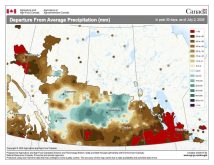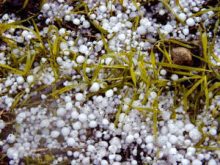Parts of the Canadian Prairies may see warm and dry conditions this summer, but not before a healthy amount of precipitation in the spring.
Drew Lerner, founder, president and senior agricultural meteorologist for World Weather Inc. in Overland Park, Kansas, added that Alberta may see milder temperatures this spring while Manitoba and parts of Ontario may be stuck with winter weather for a while yet.
“As you advance from west to east, (an early spring thaw) would be a possibility, but the East will be cold longer than the West will,” he said.
Read Also

June brings drought relief to western Prairies
Farmers on the Canadian Prairies saw more rain in June than they did earlier in the 2025 growing season
Lerner anticipates the mercury to rise yet again this summer in Manitoba as well as in southwestern Ontario. Unlike last year though, the warmer weather will follow cooler temperatures and normal amounts of precipitation in springtime, which he called “favourable.”
“The southern part of the Prairies, especially the southeast, will dry down, but only after April and May, maybe in June, generates a good distribution of rain and sunshine,” Lerner explained. “We’re not going to perpetuate the drought all the way through. We’ll see rain before we’ll dry again.”
He also said that early-planted and fall grain crops will fare best in the conditions, while corn and soybeans may struggle with a lack of soil moisture.
Weather conditions in Canada in the next few months could hinge upon two potential systems: La Niña, which could provide a cooling effect in the summer, and a strong ridge of high pressure in the middle of the continent which could bring warmer and drier conditions in late summer.
“(These are) what we’re watching. I don’t expect (them) to happen,” Lerner said. “That’s not the official forecast.”
Lerner’s other predictions for the next few months include cooler temperatures in Ontario and Quebec this spring, followed by less-than-normal precipitation in the summer. B.C. will see a “fairly active spring season” with lots of moisture and normal soil moisture in the summer, while Atlantic Canada may see cooler temperatures and below-normal precipitation.




















